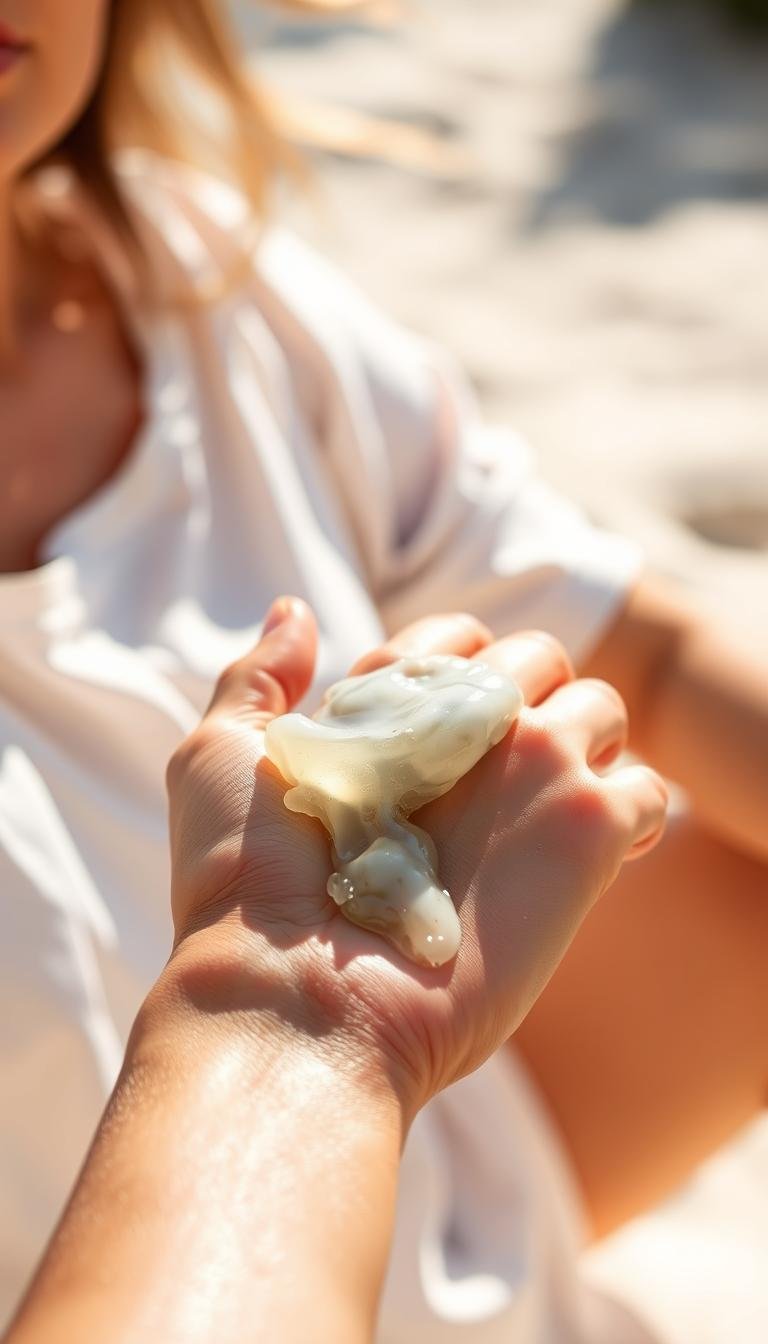(Hey! Some links in this post may be affiliate links — meaning I may earn a small commission if you buy through them, at no extra cost to you. As an Amazon Associate, I earn from qualifying purchases. I only share products I genuinely love and think you’ll find useful too. Read the full disclosure here).
Summer is here, and we’re excited to enjoy the outdoors. But we often forget to protect our skin from the harsh sun. You might have felt the pain of sunburn – the redness, pain, and peeling after a day outside without protection.
Don’t worry, we’ve got you covered! In this article, we’ll explore effective sunburn treatment options. You’ll learn how to relieve sunburn pain and soothe burned skin. You’ll get practical tips to reduce redness and peeling, so you can enjoy the outdoors again.
By the end of this article, you’ll know how to make simple, sustainable healthy choices. You’ll learn to enjoy the sun safely. Let’s dive in and discover how to find sunburn relief and keep your skin healthy and happy.
Contents
- 1 Understanding Sunburn: What Happens to Your Skin
- 2 Immediate Sunburn Relief Strategies
- 3 Proven Sunburn Relief Medications and Products
- 4 Natural Remedies for Soothing Sunburned Skin
- 5 Hydration and Nutrition for Faster Healing
- 6 Moisturizing Strategies for Sunburned Skin
- 7 Preventing and Managing Sunburn Peeling
- 8 Protecting Sunburned Skin from Further Damage
- 9 When to Seek Medical Help for Severe Sunburn
- 10 Long-term Skin Care After Sunburn
- 11 Conclusion: Creating Your Sunburn Prevention and Relief Plan
Understanding Sunburn: What Happens to Your Skin
When your skin gets sunburned, it shows UV damage. Sunburn happens when your skin gets too much UV radiation from the sun or tanning beds. This damage harms the DNA of skin cells, causing inflammation.
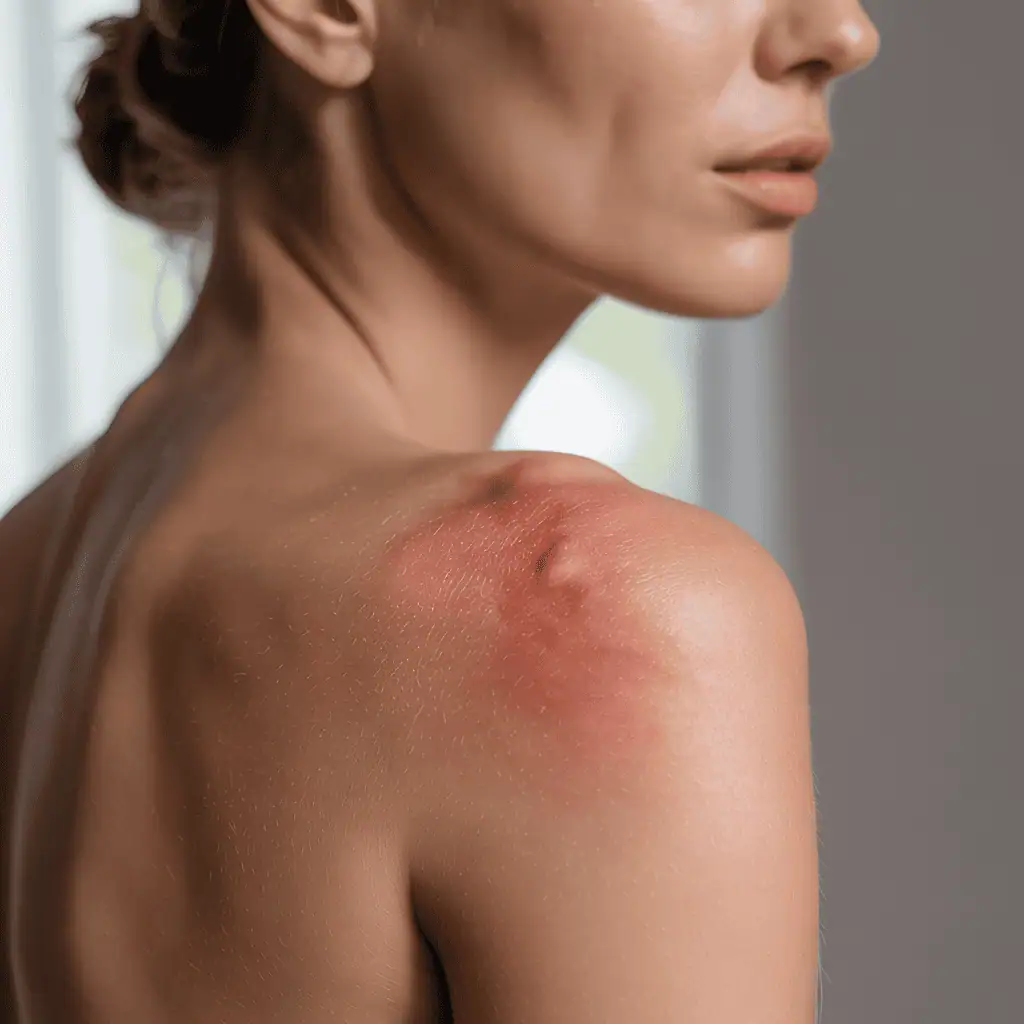
The Science Behind UV Damage
UV radiation has two types that harm the skin: UVA and UVB. UVA rays go deep into the skin, causing aging and wrinkles. UVB rays mainly cause sunburn by damaging the skin’s outer layers. Knowing this helps understand how sunburn affects your skin’s health and looks.
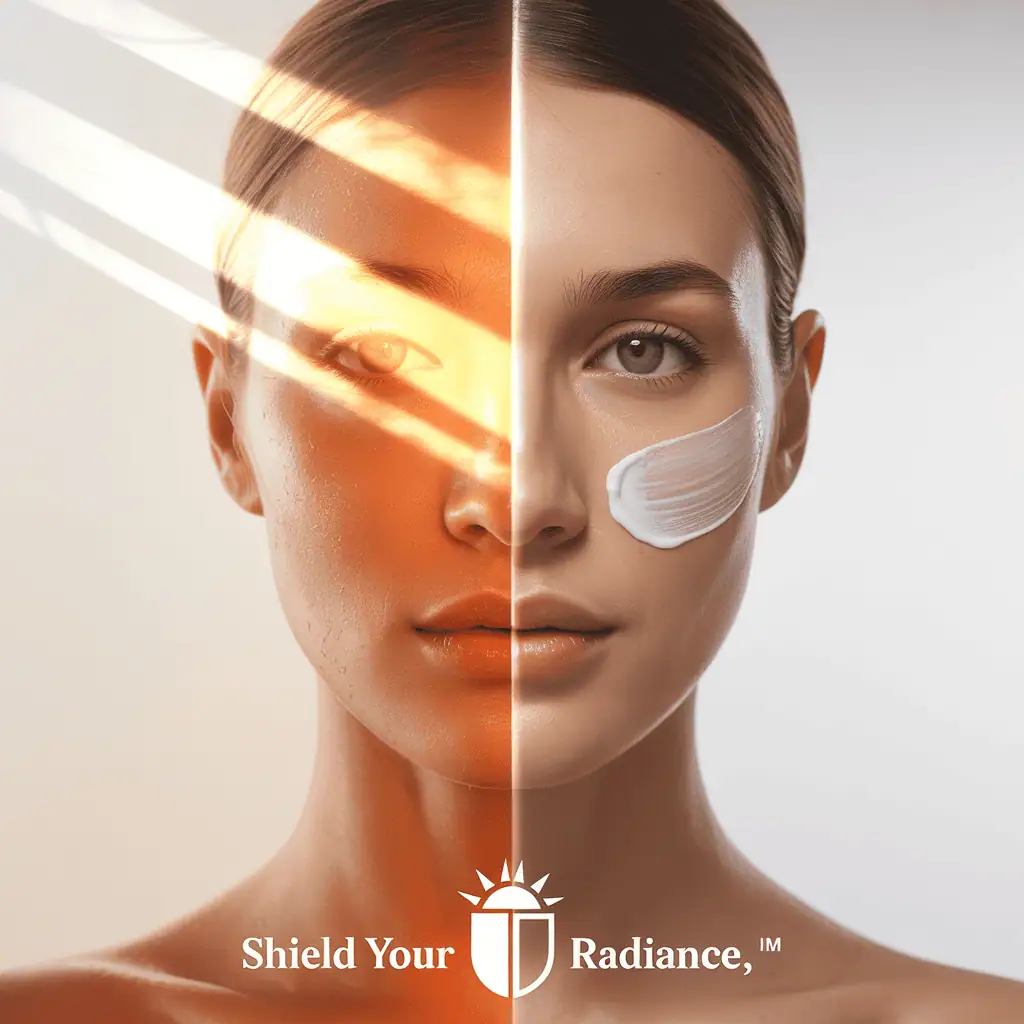
Different Types and Degrees of Sunburn
Sunburn can be mild or severe. Mild sunburn might just make your skin red. Severe sunburn can cause blisters, fever, and dehydration. Knowing how bad your sunburn is helps you find the right relief.
How Sunburn Affects Different Skin Types
Different skin types react differently to the sun. Fair skin gets sunburned easily because it has less melanin. Darker skin types have more melanin, but can also get sunburned and UV damage. Knowing your skin type helps protect it from the sun.
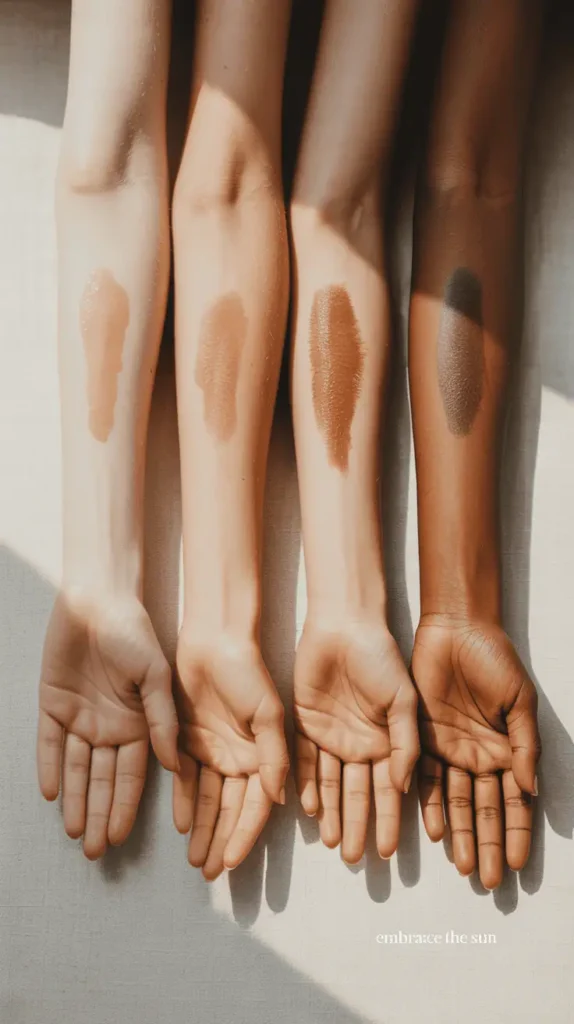
Immediate Sunburn Relief Strategies
When you get sunburned, acting fast is key. You need to cool down your skin and drink plenty of water. This helps ease the pain and stops more damage.
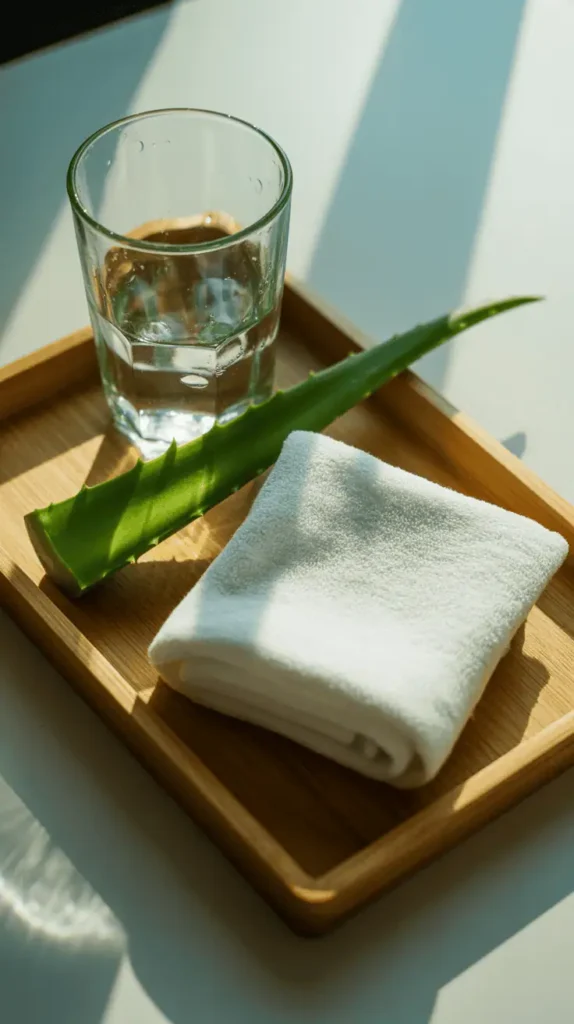
Cool Compresses and Baths
A cool compress or bath is a top sunburn remedy. Soak a cloth in cool water, wring it out, and apply it to the sunburn for 15-20 minutes. Do this a few times a day. Or, take a cool bath for relief. Adding oatmeal or baking soda to your bath can make it even better.
- Add 1 cup of colloidal oatmeal or 1 cup of baking soda to your bath water.
- Soak in the bath for 15-20 minutes.
- Gently pat dry with a towel.
Gentle Hydration Techniques
Keeping your skin hydrated is vital with sunburn. Use gentle, fragrance-free moisturizers or aloe vera gel. Apply moisturizer while your skin is damp to keep it hydrated.
What to Avoid When Skin is Burned
When your skin is sunburned, avoid harsh products and actions. Don’t use strong soaps, exfoliating scrubs, or products with alcohol or fragrances. These can dry out your skin and make it worse.
- Avoid using harsh products on sunburned skin.
- Refrain from popping blisters or peeling skin.
- Stay out of the sun until your sunburn has healed.
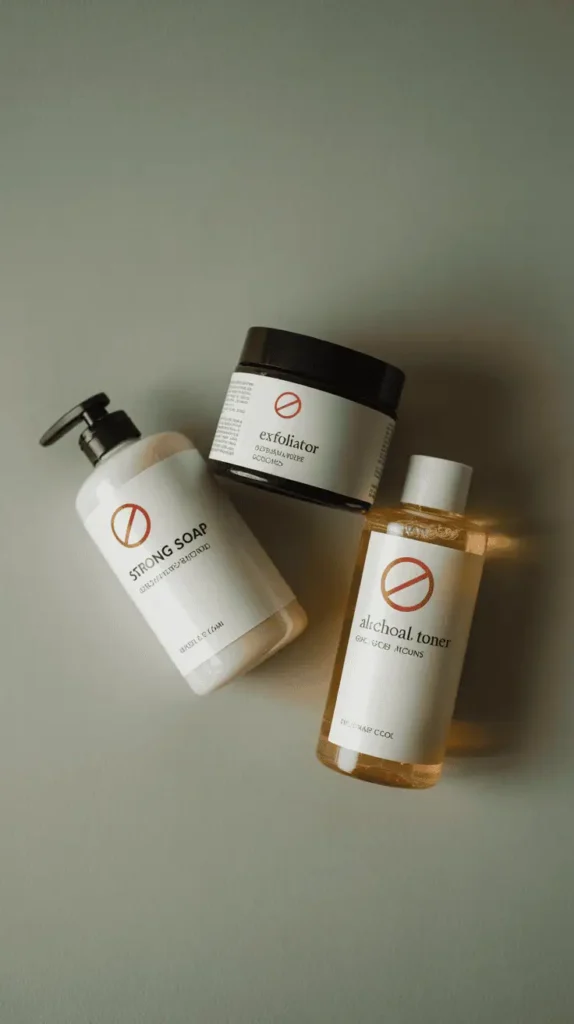
Proven Sunburn Relief Medications and Products
When it comes to sunburn relief, the right medications and products can make all the difference. You have several options to alleviate the discomfort and support the healing process.
Anti-inflammatory Pain Relievers
Over-the-counter pain relievers like ibuprofen can help reduce inflammation and alleviate pain associated with sunburn. These medications work by targeting the source of the pain and reducing the inflammation that causes discomfort.
Topical Anesthetics and Cooling Gels
Topical anesthetics and cooling gels provide quick relief by numbing the skin or cooling it down. Products containing aloe vera or menthol are effective for soothing sunburned skin. Look for products with natural ingredients to minimize the risk of further irritation.
Specialized Sunburn Relief Sprays
Specialized sunburn relief sprays are another convenient option. These sprays often combine cooling agents with moisturizers to provide immediate relief and help hydrate the skin. When choosing a spray, consider the ingredients and look for products that are gentle on sunburned skin.
By exploring these options, you can find the right combination of products to effectively manage sunburn discomfort and support the healing process.
Natural Remedies for Soothing Sunburned Skin
Nature has many gentle and effective ways to help with sunburn. If you’ve spent too much time in the sun, these remedies can soothe and heal your skin.
Aloe Vera: Nature’s Sunburn Healer
Aloe vera is known for its soothing effects. It’s rich in vitamins A, C, and E, which calm the skin and aid in healing. Apply aloe vera gel to the sunburned area to lessen redness and swelling.
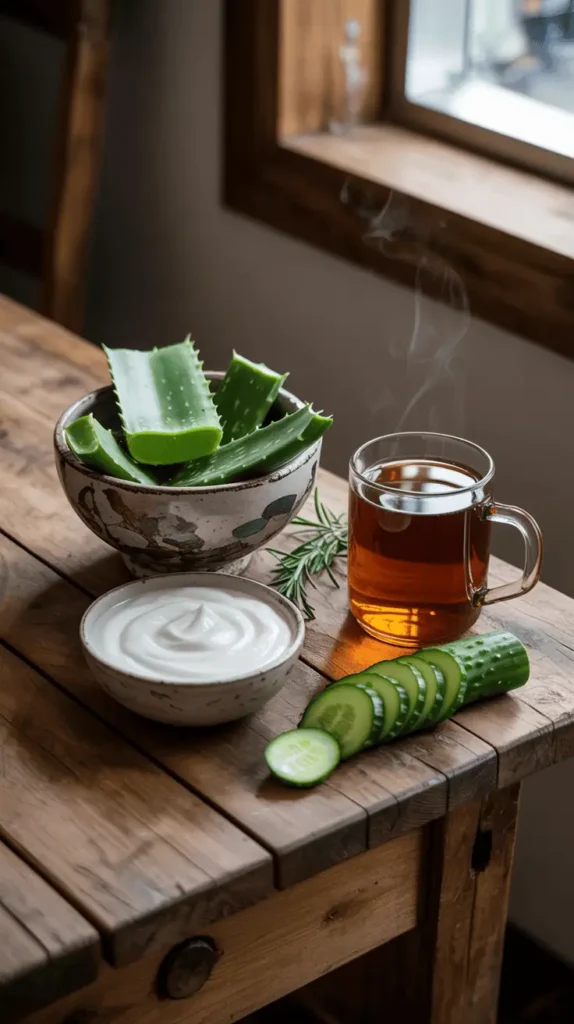
Oatmeal Baths and Treatments
Oatmeal has been used for ages to calm skin irritations, like sunburn. Colloidal oatmeal in bath water can ease itching and swelling. You can also make a paste with oatmeal and water for direct application.
Cucumber and Tea Compresses
Cucumber and tea are natural remedies for relief. Cool cucumber slices can be applied to sunburned skin to cool it down. Cool tea compresses also help reduce inflammation and soothe the skin.
Yogurt and Honey Applications
Try a yogurt and honey mix for an extra cooling treatment. The probiotics in yogurt soothe the skin, while honey’s antibacterial properties aid in healing.
These natural remedies offer many options for easing sunburn discomfort. By adding them to your sunburn relief routine, you can help your skin heal more comfortably and effectively.
Hydration and Nutrition for Faster Healing
Sunburn recovery isn’t just about treating the skin; it’s also about what you do from the inside out. When you’ve been sunburned, your body’s ability to heal is significantly influenced by your hydration levels and nutritional intake.
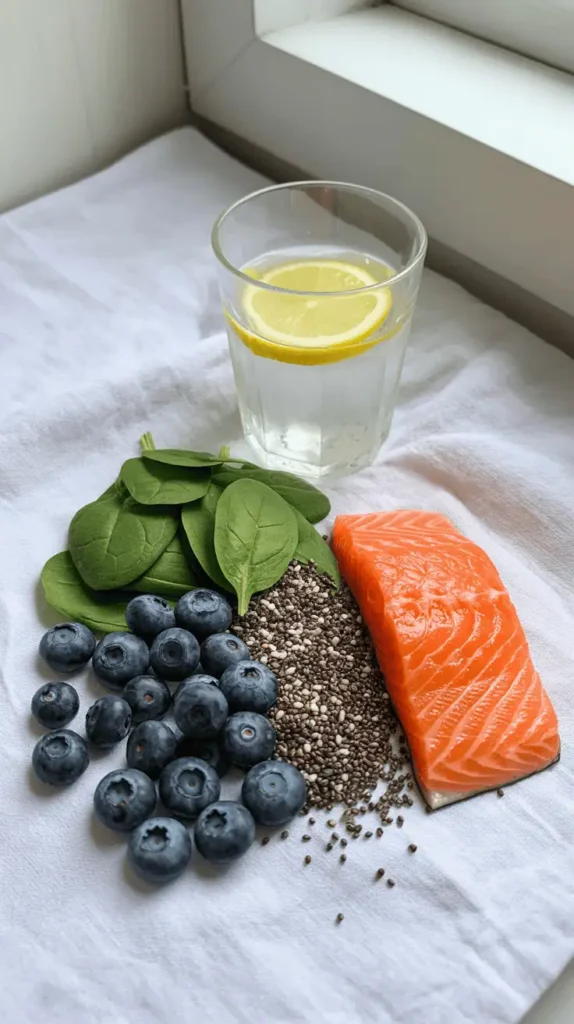
Importance of Internal Hydration
Drinking plenty of water is key to replenishing lost fluids and supporting skin health. Hydration for sunburn is essential as it helps your skin to regenerate and heal faster. Aim for at least eight glasses of water a day, and consider increasing your intake if you’re experiencing severe sunburn.
Foods That Support Skin Repair
Incorporating the right foods into your diet can significantly aid in the recovery process. Skin repair foods rich in antioxidants, vitamins, and minerals can help mitigate sun damage. Some beneficial options include:
- Berries high in antioxidants
- Leafy greens rich in vitamins A, C, and E
- Nuts and seeds packed with healthy fats and zinc
- Fatty fish containing omega-3 fatty acids
Supplements That May Help Recovery
While a balanced diet is key, certain recovery supplements can provide additional support. Omega-3 fatty acids, vitamin D, and probiotics are known to promote skin health and aid in the healing process. But, it’s essential to consult with a healthcare professional before adding any new supplements to your regimen.
Moisturizing Strategies for Sunburned Skin
To help your skin recover from sunburn, it’s vital to use the right moisturizing strategies. Moisturizing is a critical step in soothing sunburned skin and promoting the healing process.
Best Moisturizers for Sunburn Recovery
For sunburned skin, you need a moisturizer that is gentle, non-comedogenic, and rich in soothing ingredients. Look for products containing aloe vera, vitamin E, or hyaluronic acid. These ingredients help lock in moisture and support skin repair.
- Aloe vera gel: Known for its soothing and anti-inflammatory properties.
- Moisturizing creams: Rich in emollients and humectants to hydrate the skin.
- After-sun lotions: Designed to soothe and cool sunburned skin.
Application Techniques for Sensitive Skin
When applying moisturizer to sunburned skin, be gentle to avoid further irritation. Use a light touch and apply the product in a gentle, sweeping motion. You can also store your moisturizer in the refrigerator to enhance its cooling effect.
- Apply moisturizer immediately after bathing or showering while the skin is damp.
- Use a generous amount to cover all sunburned areas.
- Reapply frequently throughout the day, after being in the sun or washing your hands.
Ingredients to Look For and Avoid
When choosing a moisturizer for sunburned skin, select products with soothing and nourishing ingredients. Avoid products with alcohol, fragrances, or other irritants that can worsen sunburn.
Beneficial ingredients include:
- Hyaluronic acid for its hydrating properties.
- Vitamin E for its antioxidant benefits.
- Aloe vera for its soothing and anti-inflammatory effects.
By choosing the right moisturizer and applying it correctly, you can help your sunburned skin heal more quickly. This reduces the discomfort associated with sunburn.
Preventing and Managing Sunburn Peeling
When your sunburned skin starts to heal, it may peel. This is a natural part of the healing process. Sunburn damages the outer skin layer, causing it to dry out and peel as it regenerates.
Why Sunburned Skin Peels
Too much UV radiation damages skin cells and the outer skin layer, causing sunburn. As this damaged skin heals, it peels to make way for new skin cells. This process can be uncomfortable, but it’s a sign that your skin is recovering.
Gentle Exfoliation Methods
To manage sunburn peeling, gentle exfoliation can help remove dead skin cells. Use a gentle scrub or a chemical exfoliant with alpha-hydroxy acids (AHAs) or beta-hydroxy acids (BHAs) to loosen and remove peeling skin. Be careful not to over-exfoliate, as this can further irritate your skin.
Moisture Retention Techniques
Keeping your skin moist is key to reducing sunburn peeling. Apply a rich moisturizer right after bathing or showering while your skin is damp. Look for products with hyaluronic acid, ceramides, or niacinamide, which help keep moisture in and support the skin’s barrier. Reapply moisturizer throughout the day, after washing your hands or taking a shower.
Understanding why sunburned skin peels and using gentle exfoliation and moisture retention can help. This way, you can lessen the discomfort of sunburn peeling and support your skin’s natural healing.
Protecting Sunburned Skin from Further Damage
After getting sunburned, it’s important to protect your skin from more harm. This helps your skin heal and prevents long-term damage.

Clothing and Sun Protection
Wearing the right clothes is a great way to protect sunburned skin. Choose loose, lightweight clothes that cover the sunburned areas. Look for clothes with a UPF (Ultraviolet Protection Factor) rating of 50+.
UPF clothing is a game-changer for sun protection, as it blocks harmful UV rays.
Safe Sun Exposure After a Burn
When you have sunburn, limit your time in the sun until your skin heals. If you must go outside, stay in the shade, mainly during peak sun hours (10 am to 4 pm). Use a broad-spectrum sunscreen with a high SPF on unaffected areas. Reapply every two hours or after swimming or sweating.
- Seek shade whenever possible
- Use a wide-brimmed hat to protect your face and neck
- Avoid being outside during peak sun hours
Rebuilding Your Skin’s Natural Barrier
Sunburn damages the skin’s natural barrier, making it more prone to infection and irritation. To rebuild this barrier, keep your skin moisturized with gentle, fragrance-free lotions. Ingredients like aloe vera and hyaluronic acid can soothe and hydrate your skin.
Gentle care is key to helping your skin recover from sunburn and regain its natural protective functions.
When to Seek Medical Help for Severe Sunburn
Knowing when to get medical help for severe sunburn is key to avoiding long-term harm. Mild sunburns can be treated at home. But, severe cases can cause serious health issues.
Warning Signs of Serious Burns
Watch your sunburn for signs it might be more serious. Blistering, fever, and chills mean it’s not just a simple burn. It could be sun poisoning or something worse.
Symptoms of Sun Poisoning
Sun poisoning, or severe sunburn, shows up with nausea, headache, and dehydration. If you or someone you know has these symptoms after sun exposure, get medical help right away.
Medical Treatments for Severe Cases
Medical treatments for severe sunburns include prescription creams and oral meds. They help reduce pain and swelling. In bad cases, you might need to stay in the hospital to treat dehydration and prevent infection.
Doctors say, “Early treatment is key to avoiding long-term damage from severe sunburn.” So, knowing the warning signs and getting medical help when needed is very important.
Long-term Skin Care After Sunburn
After a sunburn, you need to take care of your skin carefully. This helps prevent long-term damage. It’s important to repair your skin, stop it from getting worse, and watch for any changes.
Repairing Sun Damage
To fix sun damage, use products with antioxidants and skin regenerators. Look for creams or serums with retinol or vitamin C. Keeping your skin well-hydrated is also key.
- Use gentle, nourishing moisturizers daily.
- Apply products with SPF to protect against further UV damage.
- Consider professional treatments like chemical peels or laser therapy for severe damage.
Preventing Premature Aging
To stop early aging after sunburn, protect your skin from the sun and use anti-aging products. Antioxidants fight off aging free radicals. Wear protective clothes and stay in the shade when the sun is strong.
Monitoring for Skin Changes
Watch your skin for any changes after sunburn. This helps catch skin problems early, like skin cancer. Look out for new moles, texture changes, or odd feelings. Do regular self-checks and see a dermatologist yearly.
With a good long-term skin care plan, you can make your skin healthier and more resilient after sunburn.
Conclusion: Creating Your Sunburn Prevention and Relief Plan
Now that you know how to soothe sunburned skin and prevent more damage, it’s time to act. Creating a detailed sunburn relief plan is key to enjoying the outdoors safely. It helps keep your skin healthy and protected.
Start by adding these tips to your daily routine. Use gentle hydration, apply topical anesthetics, and wear protective clothes. Being proactive about sunburn prevention lowers the risk of severe sunburn and long-term skin damage.
To make a good sunburn relief plan, think about your lifestyle, skin type, and outdoor activities. Find the best sunburn relief products and medications for you. Being prepared lets you enjoy the sun safely and keep your skin healthy and strong.

